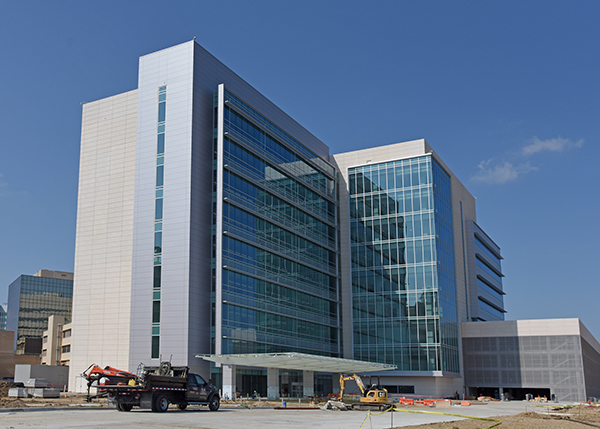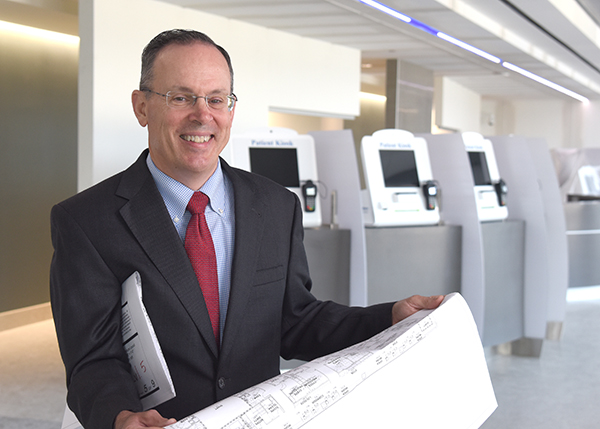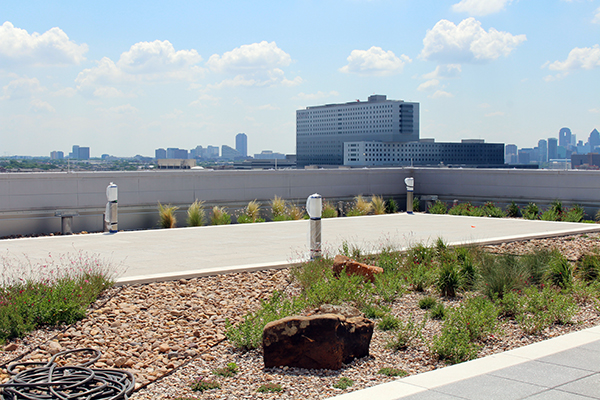New building ushers in first phase of West Campus as UTSW’s ambulatory hub
The bricks and mortar are set. Next comes high-tech equipment, furnishings, and (starting this summer) people – staff, faculty, and learners. By late summer, the brand-new West Campus Building 3 will open to patients.
As of May 23, the 2-year construction project was completed on the newest UT Southwestern professional office building. The 305,000-square-foot facility – called West Campus Building 3 – is scheduled to open in three phases. All clinics will be open by August 6. The building is at 2001 Inwood Road, south of Professional Office Buildings 1 and 2, at the site of the former St. Paul University Hospital.
The building is home to a state-of-the-art Simulation Center, ambulatory clinics, and academic departments – marking the first time UT Southwestern has brought together its clinics with their corresponding academic offices. In addition to the Sim Center, other occupants moving into the new space are Urology, the Clinical Heart Center, Vascular Surgery, Otolaryngology, and Internal Medicine Subspecialties.

Many providers and staff moving into the new building will be coming from the James W. Aston Ambulatory Care Center building on South Campus. (See sidebar for details.)
“We are excited about the addition of West Campus Building 3, which is the first of several phases of growth that will unfold over the next 20 years,” said Dr. John Warner, UT Southwestern Executive Vice President for Health System Affairs.
“This phase lays the foundation for a revamped, revitalized West Campus that now becomes the center of ambulatory clinics on the main campus. West Campus Building 3 will be home to one of the most advanced simulation centers in the country, and the new facility allows us to integrate outpatient clinical care with medical education and training, as well as with academic offices, all in support of multidisciplinary teamwork and collaboration,” he added.
Novel design

Planning for the building’s innovative design was patterned after the model used for the William P. Clements Jr. University Hospital, said Dr. Stan Taylor, Dermatologic Surgeon and Associate Vice President for Ambulatory Space Planning.
Design for the open-concept facility included input from patient focus groups and clinic occupants, who all contributed ideas throughout the process.
Upon arrival, the first thing that patients, visitors, and staff will notice is a canopy outside the front entrance – large enough to accommodate a dozen cars – that provides cover during inclement weather. Beyond the canopy, the facility sports a 776-space parking garage with both valet and self-parking options.
Once patients enter the building, they’ll have the option of using kiosks on the first floor, where a staff member will greet them and guide them through the pre-check-in process.
Levels four through eight will have the clinicians’ academic offices on one side of the floor and their clinic and clinic staff on the other side of the floor, so they can move easily between the two.
“This way, our busy clinical faculty will be able to move seamlessly between the academic side of their life and the ambulatory patient care side,” Dr. Taylor said. “That really should help people who come to UT Southwestern to see patients, to train individuals, or to do clinical research. They can do it all on one floor, in one building.”
It will also enable physicians to be more accessible to their patients.

In addition to ample parking, employees will likely appreciate the addition of two rooftop gardens – on the fourth and ninth floors. “We designed the interiors to look out on those gardens,” Dr. Taylor said.
Rather than being on the exterior wall, academic offices are pulled into the interior of the floor. The exterior walls are glass, drawing light into the space and allowing people to walk around the perimeter of the floor and look out onto the gardens and striking views of the Dallas skyline.
“The academic and clinic staff will be able to experience that every day,” Dr. Taylor said. “I really think the staff will love this building.”
State-of-the-art Simulation Center
The $40 million Simulation Center, which occupies the entire second and third floors of the new building, is one of the most advanced simulation centers in the country. The facility offers UTSW learners the latest high-tech simulators, which closely replicate diseases and conditions that providers encounter in the real world – all part of UT Southwestern’s commitment to producing exceptionally trained health care professionals and ensuring the highest standards of safety and care. The facility will be used to train faculty, medical students, residents, fellows from the graduate medical education program, and learners from the School of Health Professions, among others.
“We can find simulation centers of similar size nationally, but as far as verifying proficiency through simulation for learners of all levels across our entire campus, this is quite unique,” said Dr. Daniel Scott, Assistant Dean, Simulation and Student Integration at UT Southwestern Medical School, who also oversees the Simulation Center. “It’s state-of-the-art. Cameras and video recordings allow for everything to be observed firsthand or preserved for later viewings and debriefings.”
Twenty standardized patient rooms are available to train health care providers, with their education further enhanced by interchangeable high-fidelity manikin rooms, task training spaces, dedicated classrooms, and other labs and facilities.
Dr. Taylor said the building’s design is novel not just for UT Southwestern, but for academic medical centers in general.
“We think it will be the gold standard internationally for other countries that hope to have something like this for their medical trainees,” Dr. Taylor said.
Just the beginning
Following the construction of Clements University Hospital, the West Campus was reimagined and designated as the ambulatory hub for UT Southwestern. The new West Campus Building 3 tower is the beginning of several phases that will eventually bring more than 1 million square feet of outpatient clinical care, medical education and training, and academic offices together into one integrated campus that connects seamlessly with the comprehensive master plan of UT Southwestern and the overall Southwestern Medical District.
The $875 million West Campus Facilities Master Plan will unfold in five phases over 20 years.
West Campus Building 3
Size: Nine stories, 305,000 square feet, with a 776-space parking garage
What’s inside? The academic and clinical building is home to faculty offices, outpatient clinics, and a state-of-the-art Simulation Center.
Clinical space: 220 exam and procedure rooms for multiple specialties. Home to the Clinical Heart Center and Vascular Surgery, Otolaryngology (ENT), Urology, Phlebotomy (blood draw lab), Simulation Center, and Internal Medicine Subspecialties including Endocrinology, Infectious Diseases, and Rheumatology.
Simulation Center: The 50,000-square-foot Sim Center occupies the entire second and third floors of the new building and houses four mock operation, ICU, emergency, and obstetrical rooms; 20 standardized patient exam rooms; and six advanced technology team training rooms.
For incoming employees
If you will be working in the new building, an extensive FAQ document is available on the West Campus Planning page on the Health System portal under the Project Overview section. If you don’t find the answer to your question, email or call the key contact for that area or send a message to WestCampusProjectManagement@utsouthwestern.edu. The document is updated on an ongoing basis with additional information and should be a primary resource for many questions your team may have as they prepare for this move.
Late morning and early afternoon tours will be available for employees on July 25. Details are forthcoming.

